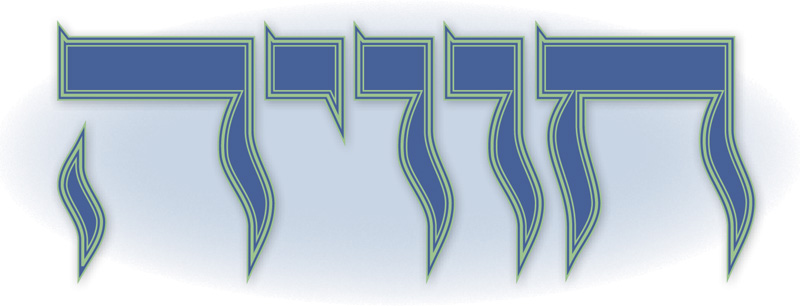language
A LANGUAGE OF
LIFE
by RABBI DAVID GEDZELMAN
M
odern Hebrew reflects many innovations of language that were purposely developed and introduced by a range of thinkers,
writers and leaders in the context of one of the Zionist movement’s greatest achievements: the resurrection of the
Hebrew language. One of those thinkers was Aharon David Gordon, who came to the Land of Israel during the Second Aliyah
in 1904 at the age of 48 and who was a significant spiritual teacher for the founders
of practical Zionism and Labor Zionism. He lived out his years at Degania, the first Kibbutz. In his expansive collection
of Hebrew essays called HaAdam veHaTeva, The Human and Nature (1910), he laid out his thinking on how
building a new life for the Jewish people in the Land of Israel could manifest a more healthy and natural relationship
 between human potential and the majesty of nature than what he believed was happening in the mechanized and unnatural
trajectory of the industrial world. At the center of Gordon’s teaching was a two-fold notion of the Human, which
comprised two essential anthropological elements: 1) the visceral element of human experience that plugs directly into
the pulse and flow of nature in an unmediated way, for which Gordon coined the new Hebrew word, Chavaya, and 2)
the conscious element of human experience that gives people the ability to analyze, perceive and objectify the world
around them, and which Gordon called Hacarah, intellection or perception.
between human potential and the majesty of nature than what he believed was happening in the mechanized and unnatural
trajectory of the industrial world. At the center of Gordon’s teaching was a two-fold notion of the Human, which
comprised two essential anthropological elements: 1) the visceral element of human experience that plugs directly into
the pulse and flow of nature in an unmediated way, for which Gordon coined the new Hebrew word, Chavaya, and 2)
the conscious element of human experience that gives people the ability to analyze, perceive and objectify the world
around them, and which Gordon called Hacarah, intellection or perception.
For Gordon, the problem of the industrialized world was one in which the Hacarah was disconnected from the Chavaya and overshadowed it. Modern human beings were all intellection and objectification cut off from their root in nature. This unnatural human condition contradicted the ideal Gordon posited, by which the Human is at one with the cosmos, making nature more beautiful rather than using the mind to pollute and corrupt the natural environment. When human beings achieve a more natural relationship to nature, the Chavaya feeds and fuels the true potential of the Hacarah and human intelligence perfects and enhances the natural environment; human enterprise and technology contribute to the majesty of nature rather than being a blight on it. In describing this utopian vision, Gordon referenced a verse from the Hebrew Bible calling the Chavaya “oil for the lamp” of the Hacarah (Ex. 25:6) — an allusion to the Biblical Menorah that is meant to illuminate the world.
In creating this new word, Gordon interposed the Hebrew word for being or existence, Havaya, with the Hebrew word for life or alive, Chai. In so doing, he changed the initial letter of Havaya from a Heh to a Chet, yielding this new word which puts life and existence together, identifying the earthly phenomenon of life as the ultimate expression of all existence. By seeing the Chavaya as the gut element of Human experience, Gordon viewed Human beings as the highest realization of Creation. Gordon was clearly aware from his religious background and education that the word Havaya was used in Hasidic tradition to pronounce the four letter name of God related to the Kabbalistic notion of how the Divine flows into and constitutes existence. Gordon’s naturalization and humanization of the theological in the coining of a word represents a world view that puts tremendous faith in what human beings can achieve if they are in healthy relationship with the cosmos. This fit his role in inspiring a generation of Zionist pioneers to see Jewish settlement in the land as a creative human enterprise rather than something that needed to wait for Divine supernatural action.
Although the subtleties of Gordon’s philosophical views and teachings were not understood in a widespread way, the use of this new word caught on and became part of the Modern Israeli vocabulary. Israelis use the word Chavaya to mean an experience of intense feeling or to reference an event in which one feels the power of life in an intense way. Without necessarily being conscious of it, by using a word which structurally means “life-existence” to speak about intense experience, Israelis reveal a cultural predilection for life and living with intensity. Without necessarily understanding the complexities of Gordon’s philosophy, the use of this word in common parlance reflects a civilizational commitment to living a bigger life. As Ari Shavit argues in the conclusion to his recent book, My Promised Land: The Triumph and Tragedy of Israel, what Israel has to offer is “the intensity of life on the edge” (Spiegel & Grau, 2013, p. 418). He goes on to say, “I think Zionism was about regenerating Jewish vitality. The Israel tale is the tale of vitality against all odds.” Those of us who have spent time in Israel know what Shavit is talking about. A.D. Gordon coined a word over a century ago to put forward a beautiful view of how the reconstitution of Jewish life and the Hebrew language in the land of Israel could better the overall human condition. That goal is still a work in progress, but it is one that is reflected and expressed through the innovations and evolutions of the Hebrew language. ■
Rabbi David Gedzelman is President and CEO of The Steinhardt Foundation for Jewish Life.
| PREVIOUS ARTICLE | NEXT ARTICLE |